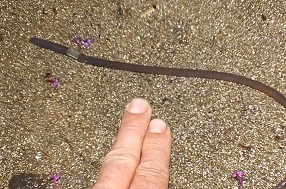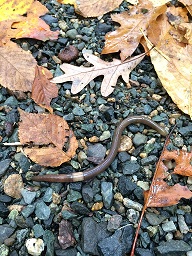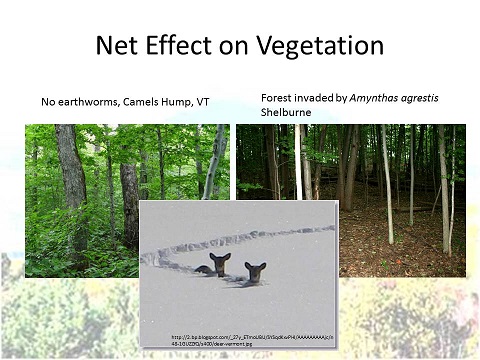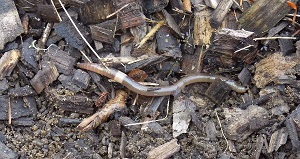Amynthas agrestis
Amynthas agrestis, more commonly known as the Asian jumping worm or crazy worm, is a species of invasive earthworm. They are relatively new in the United States and can be found in the Southeast, along the Eastern Seaboard, in the mid-Atlantic, Midwest, and some Northwestern states. They outcompete native earthworm species by taking over a section of the forest floor until the resources have been exhausted, then moving on to another section of the forest. They have a devastating effect because of their burrowing. The forest floor substrate and the vital nutrients that make up the food web of the forest, as a whole, are more scarce, lowering the overall biodiversity in areas with these worms.

Scientific Classification
| Kingdom | Phylum | Class | Order | Family | Genus | |
|---|---|---|---|---|---|---|
| Classification | Animalia | Annelida | Clitellata | Opisthopora | Megascolecidae | Amynthas |
Background
In the Northeastern US, during the last ice age around 10,000 years ago, massive glaciers scraped the bedrock bare as they receded over hundreds of years. This removed any native earthworms that were originally present in this area. Since then, humans have brought new earthworms over from Europe, and there is an ongoing debate about whether or not these species are helpful or harmful. It is generally assumed that they are doing more good than bad. The Amynthas agrestis are from Japan and Korea and are very aggressive and notably different from the European earthworms.
Crazy worms can spread to new areas by hitchhiking long distances in potted plants or mulch. There are two ways of telling if your potted plant is harboring invasive earthworms. The first way is to turn the plant upside-down and gently remove the root ball. If crazy worms are present, the roots, as well as some potting soil, may be missing. However, if only young crazy worms are present or there are very few, damage may not be evident. The second and more reliable way of telling if they are present is a mustard solution. Mix one gallon of water with 1/3 cup of ground yellow mustard seed, and pour the mixture slowly into the soil. Any worms in the soil (including the worms that benefit soil) will come to the surface and they can be checked for any invasive species.

Characteristics of Amynthas Agrestis
Amynthas agrestis can be distinguished from other worms by their darker color and by the band near their middle called a clitellum. In most worms the clitellum is puffy and similar in color to the rest of the body. In crazy worms, it is even with the body rather than puffy and has a milky white to gray color. They can appear to be iridescent, and violet colors in direct sunlight. This is not the only thing that sets them apart, Mature size and behavior help differentiate. Crazy worms are very hyperactive and slither like a snake, which is not normal of other annelids. They will shed their tails to escape predation similarly to their close relative the Alabama Jumper (Amynthas gracilis). Their vermicast (worm manure) is very large in comparison to other earthworms and has the appearance of cooked ground beef.
Because of their acrobatics, crazy worms are valued as fishing bait, and despite it being illegal in most areas, they are still commonly used as bait. To be safe, anglers should securely cover bait containers and destroy all unused bait by placing it on bare concrete and stepping on it. With a presence in Wisconsin and Minnesota, Amynthas agrestis is hardy to USDA Zone 4 and possibly colder.

Reproduction
Most earthworms are hermaphroditic, which means that they have both male and female reproductive organs, but still reproduce sexually, requiring a mate. Amynthas agrestis on the other hand, are parthenogenic, meaning they are all females and can reproduce without a mate. They reproduce by making cocoons filled with hundreds of babies that are also female, which means it only takes one crazy worm in any given area to lead to infestation.
Amynthas agrestis also matures at twice the rate of European earthworms, finishing two generations per season instead of one. Their population density is also greater than other earthworms, and they are a much larger species and grow to around 8 inches long. All of these features lead to a massive Amynthas agrestis biomass in areas where they are established. "In areas of heavy infestation, native plants, soil invertebrates, salamanders, birds and other animals may decline. By disturbing the soil, jumping worms help facilitate the spread of invasive species. Jumping worms can severely damage roots of plants in nurseries, gardens, forests and turf."[1] This includes lawns as well as the roots of annuals, perennials, and shrubs. In the forests, they destroy the native wildflowers, wiping out such plants as trillium, bloodroot, Jack-in-the-pulpit, lady slipper, and other understory plants. As these understory plants disappear, they take the understory songbirds with them. As Amynthas Agrestis infestation removes organics from soil, the soil becomes clumpy and granular making it susceptible to compaction and erosion. Forest soils actually subside, exposing tree roots. Wisconsin Department of Natural Resources invasive species specialist Bernie Williams stated “Their introduction into our state poses a huge threat to the future of our forests.”[6]

References
[1] Ceballos, Karen. 2017. Invasive Species; Jumping Worms. Cornell University Cooperative Extension.
[2] https://www.arboretum.harvard.edu/native-plants-crazy-snake-worm/
[3] Churchill, Steve. 2016. The "Crazy Worm" Infesting the Upper Midwest and Northeast US. Urban Worm Company. https://urbanwormcompany.com/crazy-worm-amynthas-agrestis
[4] Jean. 2017. Urban Forest Ecology: Voracious, Parthenogenic, Intensely Squirmy Amynthas Worms. New York State Urban Forestry Council. http://nysufc.org/worms-bad-urban-forest/2017/10/14/#more-3574
[5] http://fingerlakesinvasives.org/species-spotlight-crazy-snake-worm/
[6] https://dnr.wi.gov/topic/forestmanagement/documents/wildcards/fr-518.pdf
[7] Amynthas Agrestis. INaturalist.org. https://www.inaturalist.org/taxa/364093-Amynthas-agrestis